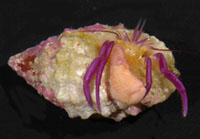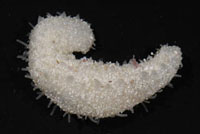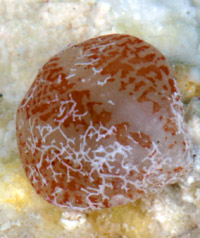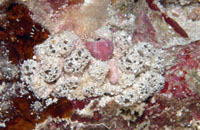|
You
are here: /main/research
expeditions/CReefs 2006/features/newspeciesandrecords
New Species and New Records Found by the Expedition
To learn more about how new species, or new records for areas are determined click here.
|
Photo: Gustav Paulay
Date Found: 10/13/06
Scientific Name: Leiaster sp.
Family: Ophidiasteridae
Common name: purple sea star
Described/undescribed?: undescribed
Unknown to expedition members?: No; seen earlier by
Scott Godwin
Common organism type (i.e., coral,
crab, worm): sea star
Where collected: FR-15-2, (Fore reef, 15 meters)
Identified by: Gustav Paulay
Collection Method used: hand
Where found (i.e., FFS, NWHI, HI,
Pacific, Worldwide): NWHI
Endemic?: yes?
Interest/significance: Previously collected by Scott
Godwin at Pearl and Hermes, this striking sea star
appears to be a NWHI endemic. Leiaster sea stars are
usually hidden during the day and only emerge at night;
they also tend to be red or be mottled with red. This
species is out in the day and is a striking purple
in color!
|
 |
Photo: Gustav Paulay
Date Found: 10/14/06
Scientific Name: Dardanus sp.
Family: Diogenidae
Common name: hermit crab
Described/undescribed?: probably undescribed
Unknown to expedition members?: yes
Common organism type: hermit crab
Where collected: FR-25-3 (Fore reef, 25 meters)
Identified by: Gustav Paulay
Collection Method used: hand
Where found (i.e., FFS, NWHI, HI, Pacific, Worldwide):
FFS only?
Endemic?: likely
Interest/significance: We have now collected species of Dardanus hermit
crabs which are potentially undescribed; this is one found in shallow habitats.
|
 |
Photo: Gustav Paulay
Date Found: 10/14/06
Scientific Name: Holothuria aff. jousseaumi
Family: Holothuriidae
Common name: sea cucumber
Described/undescribed?: potentially undescribed
Unknown to expedition members?: no
Common organism type (i.e., coral, crab, worm): sea
cucumber
Where collected: FR-10-3 (Fore reef, 10 meters)
Identified by: Gustav Paulay
Collection Method used: hand
Where found (i.e., FFS, NWHI, HI, Pacific, Worldwide):
Pacific
Endemic?: no
Interest/significance: A small sea cucumber that is unusual for its habit of attaching many grains of sand to its body. This species is widespread in the Pacific, but this is the first record from the Hawaiian Islands. The species may be undescribed. It is related to Holothuria
jousseaumi from the Red Sea.
|
 |
Photo:Andy Collins
Date Found: 10/15/06
Scientific Name: Frenulina sanguinolenta
Family: Laqueidae
Common name: reef brachiopod
Described/undescribed?: described
Unknown to expedition members?: no
Common organism type: lamp shell (brachiopod)
Where collected: LPR-3 (Lagoon Patch Reef)
Identified by: Gustav Paulay
Collection Method used: Hand
Where found (i.e., FFS, NWHI, HI, Pacific, Worldwide):
Indo-west
Pacific
Endemic?: No
Interest/significance: Brachiopods are ancient animals that dominated the seas
hundreds of millions of years ago, but today are rare in most habitats,
with only a fraction of their former diversity remaining. On coral reefs
a handful of species inhabit the reef interior, and can be encountered
in caves and in rubble. This represents the first record of the phylum
in FFS.
|
 |
Photo: Gustav Paulay
Date Found: 10/15/06
Scientific Name: Polycitor sp. (must be confirmed in laboratory)
Family: Polycitoridae
Common name: Sea squirt
Described/undescribed?: probably undescribed
New species?: probably
Common organism type (i.e., coral, crab, worm):?
Where collected: FR_2, (Fore reef)
Identified by: Tito Lotufo
Collection Method used: Hand collecting
Where found (i.e., FFS, NWHI, HI, Pacific, Worldwide):
probably only
NWHI
Endemic?: probably
Interest/significance: The polycitorids are colonial ascidians found worldwide in tropical and temperate waters. This species in particular is covered by a thin layer of coarse sand which makes them very cryptic. There are no records of this genus in the region.
|
 |
Photo: Jim Maragos/USFWS
Date Found: 10/13/06
Scientific Name: Acropora sp.
Family: Aroporidae
Common name: Coral
Described/undescribed?: Undescribed
New species?: Probably
Common organism type: Coral
Where collected: LP_1, (Lagoon Patch Reef)
Identified by: Jim Maragos
Collection Method used: Not collected, photographed only
Where found (i.e., FFS, NWHI, HI, Pacific, Worldwide): Probably only NWHI
Endemic?: Probably
Interest/significance: Although acropora are one of the most common types of coral in the Pacific they are rare in Hawaii. If this is indeed a new species it may suggest that acropora corals have evolved over a longer time period in Hawaii than what is currently thought, since there are no other acropora like it elsewhere in the Pacific.
|
*All images and information from French Frigate Shoals are provided
courtesy of the Northwestern Hawaiian Islands Marine National Monument,
Hawaiian Islands National Wildlife Refuge, the Northwestern Hawaiian
Islands State Marine Refuge, and NOAA's Pacific Islands Fisheries
Science Center in accordance with permit numbers NWHIMNM-2006-015,
2006-01, 2006-017, and DLNR.NWHI06R021 and associated amendments.
Click
on one of the following areas to follow the expedition.
Ship
Logs:
Day-by-day
activities of the ship: what research is being done that
day, what the weather is like, what's for dinner, etc.
Journals:
Daily
or semi-daily personal journal entries by the particpants
in the expedition. These journals do not necessarily reflect
the positions of any of the agencies connected with this
project.
Interviews:
Interviews with expedition participants, scientists,
vessel crew, educators, etc.
Features:
Highlights or special information such as interesting
discoveries or related research.
|
|
|